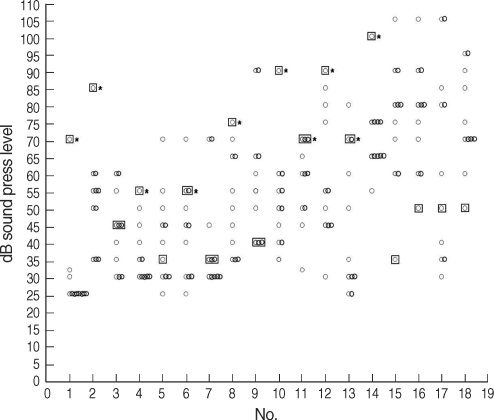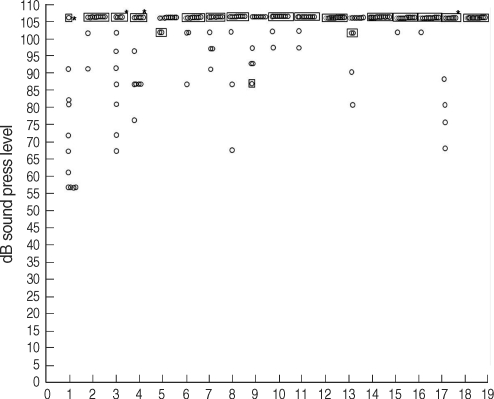Clin Exp Otorhinolaryngol.
2009 Dec;2(4):169-174. 10.3342/ceo.2009.2.4.169.
Hearing Abilities at Ultra-High Frequency in Patients with Tinnitus
- Affiliations
-
- 1Department of Otorhinolaryngology, Eulji University College of Medicine, Seoul, Korea.
- 2Department of Otorhinolaryngology, Kyung Hee University School of Medicine, Seoul, Korea. yeo2park@yahoo.co.kr
- KMID: 1466493
- DOI: http://doi.org/10.3342/ceo.2009.2.4.169
Abstract
OBJECTIVES
To compare tinnitus patients who have normal hearing between 250 Hz and 8 kHz with normal controls with regard to the ability of each group to hear extended high-frequency pure tone thresholds. METHODS: We enrolled 18 tinnitus patients, each of whom had a threshold of HL <25 dB and threshold differences of <10 dB between ears at frequencies of 250 and 500 Hz and 1, 2, 4, and 8 kHz. We also enrolled age- and gender-matched normal volunteers (10 ears), for each patient. Extended high frequency pure tone audiometry was performed, and the mean hearing thresholds at 10, 12, 14, and 16 kHz of each tinnitus ear were compared with those of the 10 age- and sex-matched normal ears. RESULTS: Of the 18 patients with tinnitus, 12 had significantly increased hearing thresholds at more than one of the four high frequencies, compared with the normal group. When we assessed results according to frequency, we found that 8 patients had decreased hearing ability at 10 kHz, 10 at 12 kHz, 8 at 14 kHz, and 4 at 16 kHz. CONCLUSION: Some patients with tinnitus who have normal hearing below 8 kHz have decreased hearing ability at extended high-frequencies. Thus, the proportion of patients with tinnitus who have normal hearing over the entire audible range is smaller than in previous reports.
Figure
Cited by 2 articles
-
Intratympanic Steroid Injection in Tinnitus Management
Hyun Joon Shim
Hanyang Med Rev. 2016;36(2):125-130. doi: 10.7599/hmr.2016.36.2.125.Efficacy of Trimetazidine Dihydrochloride for Relieving Chronic Tinnitus: A Randomized Double-Blind Study
Tolgar Lütfi Kumral, Güven Yıldırım, Güler Berkiten, Ziya Saltürk, Enes Ataç, Yavuz Atar, Yavuz Uyar
Clin Exp Otorhinolaryngol. 2016;9(3):192-197. doi: 10.21053/ceo.2015.00619.
Reference
-
1. Kiang NY, Moxon EC, Levine RA. Auditory-nerve activity in cats with normal and abnormal cochleas. In: Sensorineural hearing loss. Ciba Found Symp. 1970. p. 241–273.2. Hazell JW, Jastreboff PJ. Tinnitus. I: Auditory mechanisms: a model for tinnitus and hearing impairment. J Otolaryngol. 1990; 2. 19(1):1–5. PMID: 2179573.3. Alberti PW. Tinnitus in occupational hearing loss: nosological aspects. J Otolaryngol. 1987; 2. 16(1):34–35. PMID: 2951528.4. Coles A. Vernon JA, Moller AR, editors. Classification of causes, mechanisms of patient disturbance, and associated counseling. Mechanisms of tinnitus. 1995. Needhan Heights (MA): Allyn & Bacon;p. 11–19.5. Eggermont JJ, Sininger Y. Vernon JA, Moller AR, editors. Correlated neural activity and tinnitus. Mechanisms of tinnitus. 1995. Needham Heights (MA): Allyn & Bacon;p. 21–34.6. Ochi K, Ohashi T, Kenmochi M. Hearing impairment and tinnitus pitch in patients with unilateral tinnitus: comparison of sudden hearing loss and chronic tinnitus. Laryngoscope. 2003; 3. 113(3):427–431. PMID: 12616191.
Article7. Weiss AD, Weiss ER. Acoustic trauma: tinnitus and vertigo. J Laryngol Otol. 1984; (Suppl 9):82–83.
Article8. Pulec JL. Tinnitus: surgical therapy. Am J Otol. 1984; 10. 5(6):479–480. PMID: 6517136.9. Lockwood AH, Salvi RJ, Coad ML, Towsley ML, Wack DS, Murphy BW. The functional neuroanatomy of tinnitus: evidence for limbic system links and neural plasticity. Neurology. 1998; 1. 50(1):114–120. PMID: 9443467.10. Eggermont JJ. Central tinnitus. Auris Nasus Larynx. 2003; 2. 30(Suppl):S7–S12. PMID: 12543153.
Article11. Kaltenbach JA, Zhang J, Finlayson P. Tinnitus as a plastic phenomenon and its possible neural underpinnings in the dorsal cochlear nucleus. Hear Res. 2005; 8. 206(1-2):200–226. PMID: 16081009.
Article12. Levine RA. Somatic (craniocervical) tinnitus and the dorsal cochlear nucleus hypothesis. Am J Otolaryngol. 1999; Nov–Dec. 20(6):351–362. PMID: 10609479.
Article13. Sanchez TG, Medeiros IR, Levy CP, Ramalho Jda R, Bento RF. Tinnitus in normally hearing patients: clinical aspects and repercussions. Braz J Otorhinolaryngol. 2005; Jul–Aug. 71(4):427–431. PMID: 16446955.
Article14. Barnea G, Attias J, Gold S, Shahar A. Tinnitus with normal hearing sensitivity: extended high-frequency audiometry and auditory-nerve brain-stem-evoked responses. Audiology. 1990; 29(1):36–45. PMID: 2310352.
Article15. Jastreboff PJ, Jastreboff MM. Tinnitus retraining therapy for patients with tinnitus and decreased sound tolerance. Otolaryngol Clin North Am. 2003; 4. 36(2):321–336. PMID: 12856300.
Article16. Cutnell JD, Johnson KW. Physics. 1998. 4th ed. NewYork: Wiley.17. Ahmed HO, Dennis JH, Badran O, Ismail M, Ballal SG, Ashoor A, et al. High-frequency (10-18 kHz) hearing thresholds: reliability, and effects of age and occupational noise exposure. Occup Med (Lond). 2001; 6. 51(4):245–258. PMID: 11463869.
Article18. Ravicz ME, Olson ES, Rosowski JJ. Sound pressure distribution and power flow within the gerbil ear canal from 100 Hz to 80 kHz. J Acoust Soc Am. 2007; 10. 122(4):2154–2173. PMID: 17902852.19. Saunders JC. The role of central nervous system plasticity in tinnitus. J Commun Disord. 2007; Jul–Aug. 40(4):313–334. PMID: 17418230.
Article20. Henry JA, Dennis KC, Schechter MA. General review of tinnitus: prevalence, mechanisms, effects, and management. J Speech Lang Hear Res. 2005; 10. 48(5):1204–1235. PMID: 16411806.
- Full Text Links
- Actions
-
Cited
- CITED
-
- Close
- Share
- Similar articles
-
- The Relationship Between Tinnitus Frequency and Speech Discrimination in Patients With Hearing Loss
- The Relationship of Frequency between Tinnitus and the Maximal Hearing Loss
- Relationships of Tinnitus to Frequency and Hearing Loss in Elderly Patients
- Relationship between the Discomfort of Tinnitus and the Quality of Life in Tinnitus Patients
- Audiologic Characteristics of Unilateral Tinnitus Patients without Subjective Hearing Disturbance





